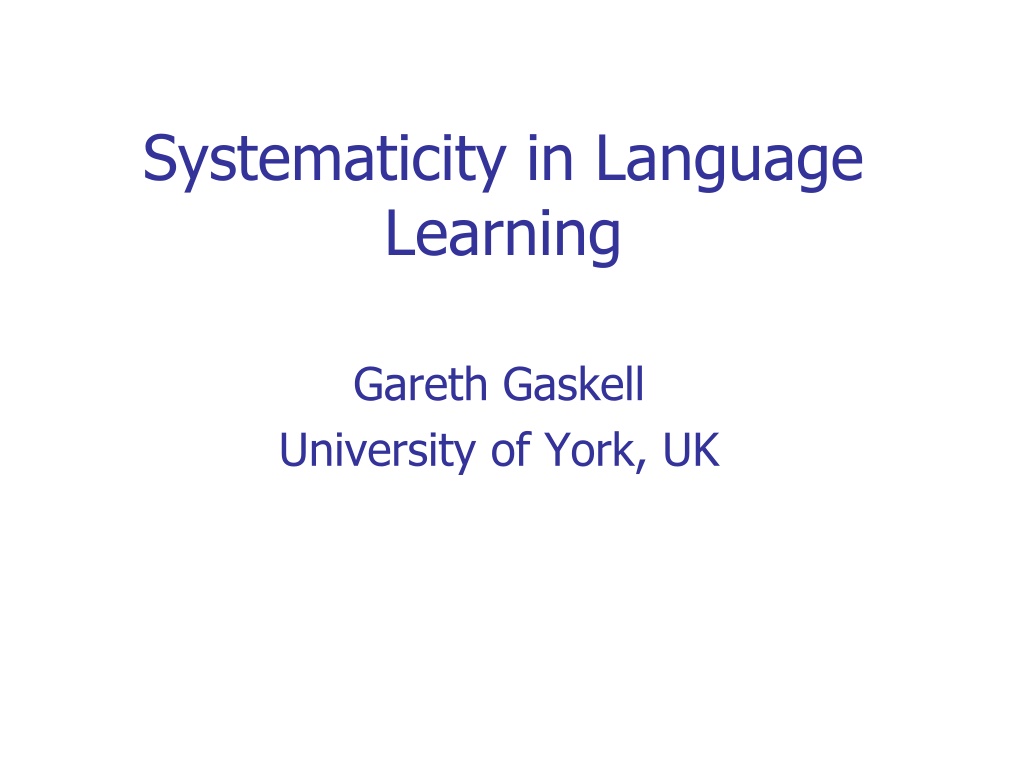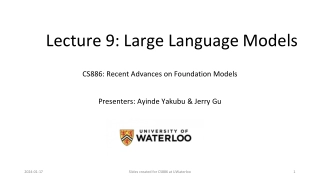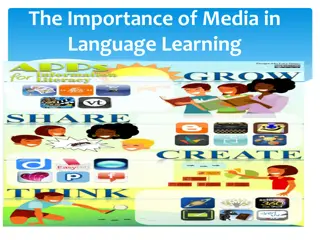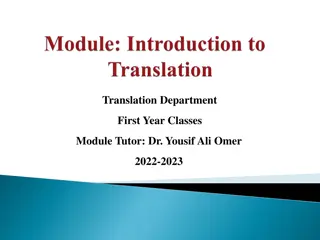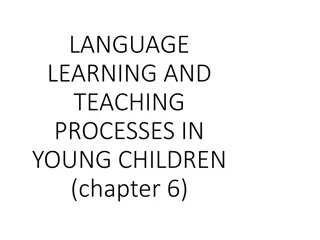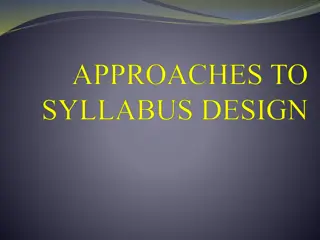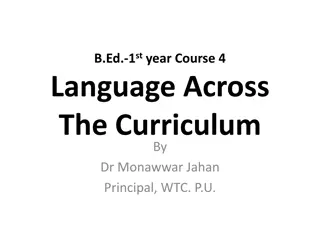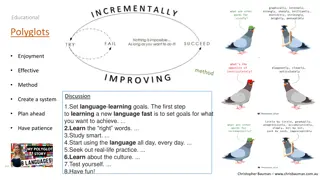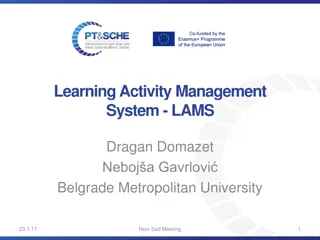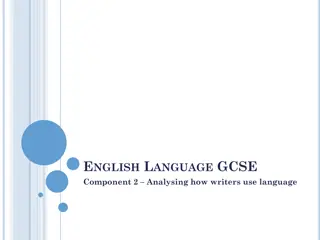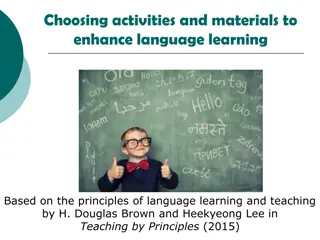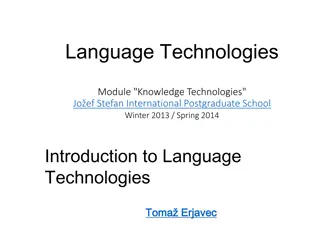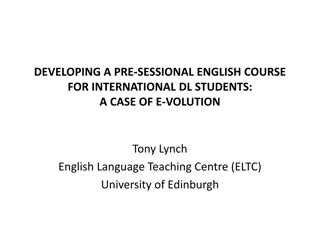Systematicity in Language Learning
Delve into the fascinating world of language learning with Gareth Gaskell from the University of York, UK. Discover the importance of systematicity in the process, uncovering valuable insights that can enhance your learning journey. This resource offers a unique perspective on how language acquisition can be optimized through structured and systematic approaches, shedding light on effective strategies for mastering new languages. Explore the intricate relationship between systematicity and language learning as you embark on your own linguistic adventure.
Download Presentation

Please find below an Image/Link to download the presentation.
The content on the website is provided AS IS for your information and personal use only. It may not be sold, licensed, or shared on other websites without obtaining consent from the author.If you encounter any issues during the download, it is possible that the publisher has removed the file from their server.
You are allowed to download the files provided on this website for personal or commercial use, subject to the condition that they are used lawfully. All files are the property of their respective owners.
The content on the website is provided AS IS for your information and personal use only. It may not be sold, licensed, or shared on other websites without obtaining consent from the author.
E N D
Presentation Transcript
Systematicity in Language Learning Gareth Gaskell University of York, UK
Systems consolidation in language (Davis & Gaskell, 2009; cf. Marr; 1970; McClelland, McNaughton & O Reilly, 1995) New items (e.g., vocabulary) involve hippocampal mediation Permanent linguistic knowledge retained in neocortex Sleep represents ideal medium for hippocampal transfer Integrating new words into the permanent lexicon?
Why do we need complementary learning systems? (CLS; McClelland et al., 1995) Catastrophic interference (McCloskey & Cohen, 1989; Merhav et al., 2014) Swift distributed cortical learning of new associations leads to interference The hippocampus steps in to separate these patterns (at least in adults, Darby & Sloutsky, 2015) But catastrophic interference is less of a problem for: Slower, interleaved learning Less arbitrary mappings with overlapping representations Does sleep have less of a role to play in these cases?
Three tests of a complementary systems/consolidation account Slower, interleaved learning Massed vs spaced incorporation in word learning Less arbitrary mappings Vary systematicity/arbitrariness of new mapping Artificial language learning with overlapping representations Vary overlap between new words and existing language Novel English past tenses
Three tests of a complementary systems/consolidation account Slower, interleaved learning Massed vs spaced incorporation in word learning Less arbitrary mappings Vary systematicity/arbitrariness of new mapping Artificial language learning with overlapping representations Vary overlap between new words and existing language Novel English past tenses
Can we learn new words without a hippocampus? (Bayley et al, 2008) Which of the following is a word? Fooble Foozle Tooble Google Toozle Gooble Foogle Goozle Toogle p = .08 p < .05
Spaced learning and testing Can interleaved learning lead to lexical engagement? Session Time Session 1 09:00 Train (12 reps) Pre-sleep Session 2 11:30 Test Train (12 reps) Session 3 14:00 Test Train (12 reps) Session 4 16:30 Test Session 5 16:30 Test Post-sleep
Results Spaced learning and testing 40 (Error bars are confidence intervals) 30 Lexcial competitor effect (ms) 20 10 0 -10 -20 -30 -40 -50 -60 2.5 5 7.5 31.5 Time since first training (hours) Post-sleep Pre-sleep Lindsay & Gaskell (2013, JEPLMC)
Spaced learning What about when testing is not repeated through the day? Session Time Session 1 09:00 Train (12 reps) Pre-sleep Session 2 11:30 Test Train (12 reps) Session 3 14:00 Test Train (12 reps) Session 4 16:30 Test Session 5 16:30 Test Post-sleep
Results Spaced Learning 40 30 Spaced Learning and Testing Lexcial competitor effect (ms) 20 Spaced Learning 10 0 -10 -20 -30 -40 -50 -60 2.5 5 7.5 31.5 Time since first training (hours) Post-sleep Pre-sleep
Spaced testing What about when only testing is repeated through the day? Session Time 36 Session 1 09:00 Train (12 reps) Pre-sleep Session 2 11:30 Test Train (12 reps) Session 3 14:00 Test Train (12 reps) Session 4 16:30 Test Session 5 16:30 Test Post-sleep
Results Spaced Testing 40 Spaced Learning and Testing Spaced Learning Spaced Testing 30 Lexcial competitor effect (ms) 20 10 0 -10 -20 -30 -40 -50 -60 2.5 5 7.5 31.5 Time since first training (hours) Post-sleep Pre-sleep
Three tests of a complementary systems/consolidation account Slower, interleaved learning Massed vs spaced incorporation in word learning Less arbitrary mappings Vary systematicity/arbitrariness of new mapping Artificial language learning with overlapping representations Vary overlap between new words and existing language Novel English past tenses
Test 1 Slower, interleaved learning can lead to integration of new words, prior to sleep Spaced testing (or retrieval practice) is particularly useful Can be explained in terms of learning properties of cortical network in a complementary systems account (McClelland et al., 1995) Although recent model argues that retrieval practice is a form of consolidation (Antony et al., 2017)
Three tests of a complementary systems/consolidation account Slower, interleaved learning Massed vs spaced incorporation in word learning Less arbitrary mappings Vary systematicity/arbitrariness of new mapping Artificial language learning with overlapping representations Vary overlap between new words and existing language Novel English past tenses
Output Space (e.g., semantics) Arbitrary mapping = strong hippocampal involvement Input Space (e.g., phonology)
Output Space (e.g., semantics) Systematic mapping = weak hippocampal involvement Input Space (e.g., phonology)
Predictions of complementary systems approach Hippocampal reliance will depend on level of systematicity (high systematicity = low reliance) Consolidation effects depending on hippocampal replay will also depend on systematicity Unsystematic or arbitrary associations will show the strongest sleep effects Test these predictions in linguistic domain Learning of a new artificial language
Systematicity (Mirkovi & Gaskell, 2016) Participants learned associations between Determiner+inflected noun and pictured referents Feminine Masculine
Systematic components Determiner and suffix represent more systematic aspects of new mapping Female Feminine
Unsystematic (arbitrary) components Stems have an arbitrary (one-to-one) mapping to the individual occupations Feminine
Experiment Design Wake group N=23 Language Training Video Testing 12 pm 1 pm 2 pm 3 pm 4 pm 5 pm Sleep group N=23 Language Training Sleep Testing
Tests of arbitrary components Wake group N=23 Language Training Video Testing Translation recognition Cued recall (picture with or without first phoneme) 12 pm 1 pm 2 pm 3 pm 4 pm 5 pm Sleep group N=23 Language Training Sleep Testing
Sleep benefits translation recognition Examples: queen bisesh : Y/N (match) nurse bisesh : Y/N (mismatch) ***
and cued recall * b
Tests of systematic components Wake group N=23 Language Training Video Testing Generalization 12 pm 1 pm 2 pm 3 pm 4 pm 5 pm Sleep group N=23 Language Training Sleep Testing
No benefit of sleep for systematic components Generalization (new items) Suffixes Determiners Proportion match response
Summary, systematicity Sleep effects (nap vs wake) Arbitrary Clear benefit of sleep over wake in memory of arbitrary components But no effect for the more systematic aspects Systematic
Morphological Generalization: Types vs. Tokens (Mirkovi , Vinals & Gaskell, 2018) Day 1: word repetition rish Day 8: word repetition rish rishaff
Language Structure (cf. English past tense) Majority low frequency regulars (spread out across phonological space) Few high frequency irregulars (clustered in phonological space) Does generalization to new items depend on regular type (more systematic) or irregular tokens (less systematic)? How does this change over time? Regular (n = 12) Irregular (n = 6) norkaff plassaff thiltaff heefaff grollaff shilnaff dowthaff frakaff rishaff Generalization examples: no cue: irregular consistent: ambiguous: clim shisp darb jispeem slispeem tispeem farbaff clarbaff yarbaff harbesh blarbesh varbesh Inconsistent
Generalization performance irregular consistent no cue Immediate ambiguous 0% 10% 20% 30% 40% 50% 60% 70% 80% 90% 100% 12 hr sleep 0% 10% 20% 30% 40% 50% 60% 70% 80% 90% 100% 12 hr wake 0% 10% 20% 30% 40% 50% 60% 70% 80% 90% 100% 24 hr 0% 10% 20% 30% 40% 50% 60% 70% 80% 90% 100% Regular Irregular
Three tests of a complementary systems/consolidation account Slower, interleaved learning Massed vs spaced incorporation in word learning Less arbitrary mappings Vary systematicity/arbitrariness of new mapping Artificial language learning with overlapping representations Vary overlap between new words and existing language Novel English past tenses
Test 2 As predicted by a complementary systems account: Consolidation tends to favour the arbitrary over the systematic Be careful when interpreting the results of artificial language learning paradigms Performance on newly learned material may not reflect final state
Three tests of a complementary systems/consolidation account Slower, interleaved learning Massed vs spaced incorporation in word learning Less arbitrary mappings Vary systematicity/arbitrariness of new mapping Artificial language learning with overlapping representations Vary overlap between new words and existing language Novel English past tenses
Consistency: overlap between new words and existing language Existing language Novel language Sleep benefit, and possibly present tense Past tense Local Neighborhoods hippocampal involvement, depends on overlap between new material and existing knowledge Regular dominant share care stare PLARE PLARED PLORE Irregular dominant sleep keep sweep FLEEP FLEEPED FLEPT Less overlap (locally) Less overlap (globally) Mirkovic & Gaskell, in prep
Test 3 Overlap with existing knowledge provides support for cortical learning Consolidation effects stronger for more novel, harder to integrate material
Conclusions To explain the time-course of language learning, we need to understand the nature of the mapping and its implications for memory systems: Fast/massed, arbitrary learning and new incompatible knowledge require hippocampal intervention, and so benefit from consolidation Slower, spaced, systematic learning and compatible knowledge engage more with cortical networks, sleep/consolidation effects are less dramatic
Thanks to... Matt Davis Nicolas Dumay Justyna Sobczak Lisa Henderson Jenni Rodd Jill Warker Jakke Tamminen Meesha Warmington Sarah Walker Vic Knowland Fay Fletcher Anna Weighall Hua-Chen Wang Shane Lindsay Courtenay Norbury Faye Smith Jelena Mirkovic
